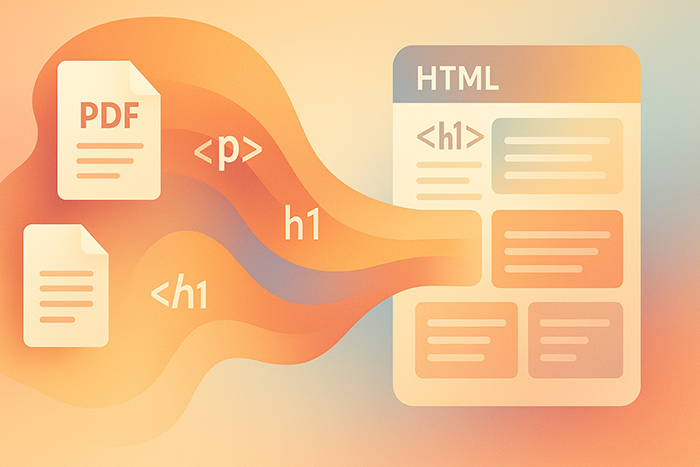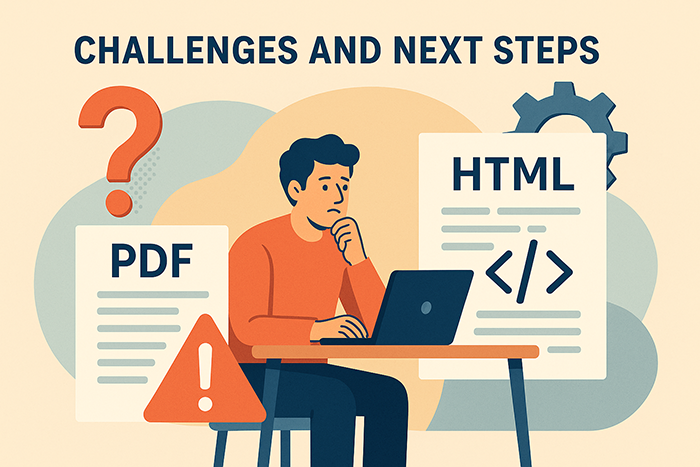Why HTML?
For several decades, PDF has been the standard format for scientific publishing. PDFs are excellent for preserving layout and appearance across platforms, but they also come with limitations: they were designed primarily for print-like display, not for flexible, accessible use.
HTML, by contrast, adapts much better to readers’ needs. It works seamlessly with screen readers, magnifiers, and mobile devices. Text can be resized, colors adjusted, and the content can be read out in a linear order. By offering HTML alongside PDF, Dagstuhl Publishing aims to lower barriers and improve access to scientific knowledge.

A Semi-Automatic but Quality-Checked Process
The conversion from LaTeX to HTML is far from trivial. Our workflow is based on the open-source tool LaTeXML, which is also used by arXiv. However, not all LaTeX packages and custom macros are supported. In some cases, this leads to display issues or failed conversions.
To maintain the quality our authors and readers expect, we rely on a semi-automatic process. Whenever possible, we resolve incompatibilities manually and then perform a careful visual check of the HTML output before publication. This requires significant additional effort but ensures that the HTML versions meet a high standard.
So far, this experimental project has proven promising: of the more than 1,000 documents processed, around 90% could be successfully converted into HTML. However, the significant additional costs are currently not covered by the APC, which already today is barely covering production costs. Therefore, HTML conversion is being run as an experimental project for the time being. Only upon a thorough evaluation of the project for a minimum period of one year, a decision will be made on whether to continue HTML support, see
Challenges and Next Steps

Not every article published after January 1, 2025 will immediately have an HTML version. We target a maximum delay of 3 months after the publication of the article (as PDF) until the HTML version will be available. Unfortunately, there might be cases where the LaTeX sources are simply too complex for a satisfying conversion result. Authors can help improve results by following best practices in LaTeX preparation – for example, by using standard commands for structuring their articles and avoiding certain problematic packages. More information is available in our FAQs:
Some readers may ask why we do not simply provide PDF/UA, the ISO standard for accessible PDFs. While this is possible in theory, the LaTeX ecosystem is not yet mature enough to support it reliably. The LaTeX tagging project is still experimental, and widespread compatibility has not yet been achieved. For now, HTML (and XML) remains the most practical and reliable format for accessibility, see also:
- Why are we not (yet) using PDF/UA as an accessible format?
- Why is HTML/XML currently the best alternative for accessibility?
Looking Ahead
The introduction of HTML at Dagstuhl Publishing is a milestone for accessibility. While we continue to publish PDFs as the primary format, the additional availability of HTML will open up our publications to a wider audience and provide better support for diverse reading needs.
All FAQs about HTML:
- Why are algorithms embedded in HTML as vector graphics rather than text?
- Why is the HTML output still labeled as BETA or experimental?
- Why do we offer HTML versions of our publications in addition to PDFs?
- Why is HTML/XML currently the best alternative for accessibility?
- How can authors improve the HTML output of their publications?
- Why is there still no HTML for my article?
- Why are we not (yet) using PDF/UA as an accessible format?
- Which packages cause problems for LaTeXML?
- How do I use the standalone package to create separate images?
To support the release, we have not only embedded the HTMLs, but also expanded the search functions of our publication server DROPS, making it easy to filter articles that are available in HTML format. For example, you can find all articles available in HTML format on the following page:
We encourage authors and readers alike to explore the new HTML versions, give feedback, and consult our FAQs for further details. Together, we can shape a more inclusive and accessible future for scientific publishing.


